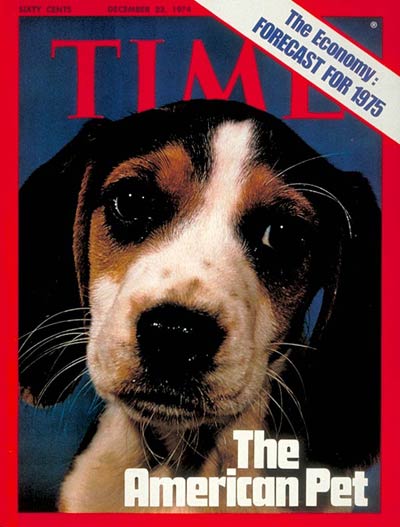
More than 12 million American households have gotten a pet in the time since COVID-19 was declared a pandemic in March 2020, according to the American Pet Products Association. The growth in pandemic-era pet adoption continues the trend of Americans turning to their pets for companionship in tough times. As TIME put it in a 1974 cover story, “During wars, insurrections and depressions, particularly, pet ownership seems to proliferate. Even in today’s recession-inflation battered economy, when the care and feeding of pets would seem an exorbitant load on the family budget, there are more and more pet owners in the U.S.—deriving, perhaps, psychological sustenance from what Kipling called the dog’s ‘love unflinching that cannot lie.'”
But though shelters and rescues have been rising in popularity in recent years, with June observed as adopt-a-cat month, their history in America is more than 150 years old.
While most Americans may associate the idea of animal shelter with adopting a pet cat or dog, the first such places tended to involve horses, with activists focused on the welfare of animals who were a key mode of transportation.
Then, on April 14, 1869, Caroline Earle White and a group of women activists established what’s considered the country’s first animal shelter, in Bensalem, Pa., outside of Philadelphia. In addition to horses, its mission expanded “to provide as soon as possible, a Refuge for lost and homeless dogs, where they could be kept until homes could be found for them, or they be otherwise disposed of.”
“The whole notion of a shelter, or even a municipal pound, as a place where you could go and find a pet, really took hold in the latter part of the 19th century and then has grown steadily ever since,” says historian Bernie Unti, a senior principal strategist at the Humane Society of the United States.
In the Progressive Era, just as social-reform activists called for the humane treatment of factory workers in an era of rapid industrialization and urbanization, so too were activists calling for the humane treatment of animals.
Get your history fix in one place: sign up for the weekly TIME History newsletter
That foundation set the country up for the post-World War II period, when pets became seen as part of the quintessential suburban American family.
TIME’s Dec. 23, 1974, cover story on “The American Pet” declared that “the U.S. today is undergoing what can only be described as an animalthusian explosion” in which “pet ownership has become almost as sacred a democratic right as if it had been written into the Constitution.” At the time, about 60% of American households had a pet, and it was becoming more common to pamper them. Today, the American Pet Products Association says the number is two-thirds of American households (67%); in March, pet products spending surpassed the $100 billion mark for the first time.

“Pet-keeping has become more intensive, just like child rearing has,” says Katherine C. Grier, author of Pets in America: A History.
But as the number of breeders increased, so did the number of cats and dogs—not all of which had homes with those pampering families. The country now had to figure out what to do with the cats and dogs that had nowhere to go.
By the 1970s, spay and neuter technology became more widely used, and animal-welfare groups like the Humane Society of the United States promoted the motto of “legislate, educate, sterilize” to reduce the number of unwanted animals. Seeing mixed-breed dogs like Benji on the big screen also helped normalize pet adoptions.
“Pushing adoption and trying to make the shelter as the first place to look for a pet was a big part of this overall strategy,” says Unti. Adoption is “a big part of” what reduced the number of animals loose in the streets, and in recent years they’ve only gotten more possible.
Among pet dogs, the percentage adopted from shelters increased from 15% in 2006 to over 35% in 2016. The Internet and social media, especially PSAs that the Ad Council started in 2009, are thought to have helped drive the rise in awareness of adoptions.
Andrew Rowan, Chief Program Officer at WellBeing International, tells TIME there are now 5,000 animal shelters and animal rescue groups in the U.S.
Animal welfare experts believe the adoption of First Dog Major will also continue to raise awareness of animal shelters and rescue groups as places to adopt pets. The Bidens join a long tradition of high-profile figures aiming to increase adoptions even more. Many celebrities have founded animal shelters: dancer Irene Castle founded Orphans of the Storm in 1928 and went onto become the President of the Westchester County, N.Y., Humane Society; Doris Day was known as “The Dog Catcher of Beverly Hills”; and The Price Is Right host Bob Barker urged viewers to make sure their pets were spayed and neutered.
It’s a mission that, even after all these years, remains necessary.
More Must-Reads from TIME
- Cybersecurity Experts Are Sounding the Alarm on DOGE
- Meet the 2025 Women of the Year
- The Harsh Truth About Disability Inclusion
- Why Do More Young Adults Have Cancer?
- Colman Domingo Leads With Radical Love
- How to Get Better at Doing Things Alone
- Michelle Zauner Stares Down the Darkness
Write to Olivia B. Waxman at olivia.waxman@time.com